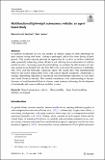Multifunctional lightweight autonomous vehicles: an agent-based study
Author(s)
Coretti Sanchez, Naroa; Larson, Kent
Download11116_2024_Article_10548.pdf (3.605Mb)
Publisher with Creative Commons License
Publisher with Creative Commons License
Creative Commons Attribution
Terms of use
Metadata
Show full item recordAbstract
In mobility-on-demand services, the number of vehicles needed is often determined by peak demand during rush hours, leading to prolonged vehicle idle times during off-peak periods. This surplus capacity presents an opportunity for vehicles to perform additional tasks, potentially enhancing system efficiency and reducing the overall number of vehicles needed in cities. Leveraging agent-based modeling, we evaluate the effectiveness of vehicles catering to on-demand rides and food deliveries in two real-life scenarios: Cambridge, MA, USA, and San Sebastian, Gipuzkoa, Spain. The results show that multifunctional behavior can lead to reduced fleet sizes, with context-specific exceptions. Additionally, a strategic dispatching algorithm is introduced that demonstrates reductions in wait times and overall distances traveled. This research contributes to the understanding of the performance of multifunctional fleets in diverse urban contexts, informing the development of sustainable and resource-efficient mobility systems.
Date issued
2024-11-27Department
Massachusetts Institute of Technology. Media LaboratoryJournal
Transportation
Publisher
Springer US
Citation
Coretti Sanchez, N., Larson, K. Multifunctional lightweight autonomous vehicles: an agent-based study. Transportation (2024).
Version: Final published version